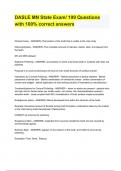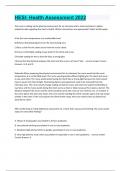Tentamen (uitwerkingen)
DASLE MN State Exam/ 199 Questions with 100% correct answers
- Vak
- Instelling
Clinical Crown - ANSWER--That portion of the tooth that is visible in the oral cavity Oral prophylaxis - ANSWER--The complete removal of calculus, debris, stain, and plaque from the teeth. DH and DDS allowed Selective Polishing - ANSWER--a procedure in which only those teeth or surfaces wi...
[Meer zien]




